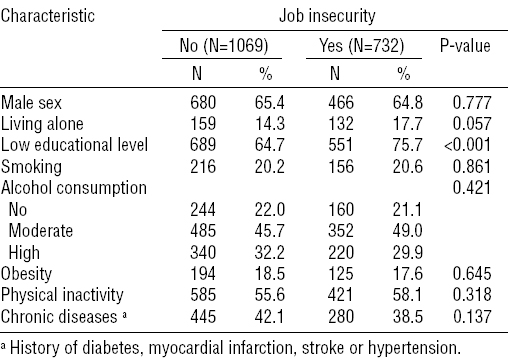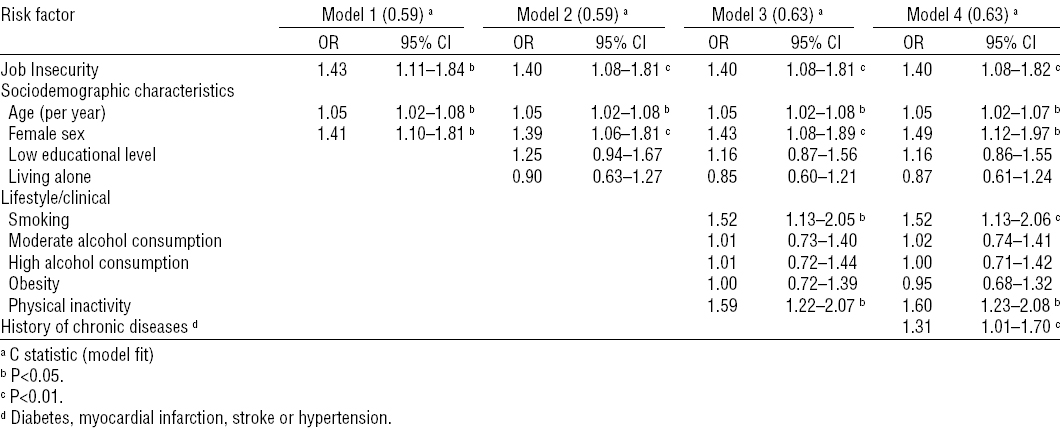Job insecurity, ie, the anticipation of unemployment, is an occupational stressor (1, 2), which has been on the rise due to structural changes to the global economy (3, 4). While an unemployed individual can take active measures that help to cope with job loss (eg, by looking for a new job), the uncertainty inherent in job insecurity impedes preparations for the future (5). Job insecurity has been associated with somatic (6–11) and minor psychiatric morbidity (6, 12–15), poorer self-rated health (8, 12, 14–16) and diminished subjective well-being (SWB) (2, 5, 17, 18).
SWB represents a multi-dimensional concept reflecting the positive dimensions of mental health and captures positive mood, vitality, future orientation and a general interest in life (19). It is commonly understood to represent the level of well-being people experience, based on a subjective evaluation (both cognitive and emotional) of their lives (20, 21). SWB has been associated with health (22) and shown to protect against negative health outcomes and mortality among older adults (23). While job insecurity has been negatively associated with SWB in the working population (17, 18), no study has yet examined the long-term consequences of job insecurity on SWB after retirement. Therefore, the aim of this prospective study was to investigate the effect of exposure to job insecurity during working life on SWB after retirement.
Methods
Setting and sample description
Data were drawn from the representative population-based MONICA/KORA (MONItoring trends and determinants in CArdiovascular disease/Cooperative Health Research in the Region of Augsburg) cohort, described in detail elsewhere (24). Two data sets were available per participant: one (T1) was collected during one of three independent surveys (S1–S3) between 1984–1995, the second at follow-up (T2) in 2009 (24). Time-to-follow-up differed depending on which survey T1 data was derived from (S1: 24 years, S2: 19 years, S3: 14 years). The local ethics committee study approved the study, which followed the declaration of Helsinki. Each participant provided written informed consent.
Analyses were restricted to employed participants at T1 (N=7466), who would reach the retirement age of 65 years by T2 (N=3255) and without missing information on any of the study variables (N=1454), leading to a final study sample of N=1801 (1146 men/655 women). A drop-out analysis revealed that missing information was associated with older age and male sex.
Mean age at T1 was 51.4 (SD 5.5) years and 71.0 (SD 4.7) years at T2. Mean follow-up was after 19.6 (SD 4.0) years.
Measures at T1
Job insecurity was assessed by questionnaire at T1 using a global single item (“Do you sometimes worry about whether you will be able to keep your current work position?), with responses scoring on a 3-point Likert scale. Participants answering “yes, frequently” or “yes, sometimes” were defined as experiencing job insecurity.
Risk factors were assessed by questionnaire or clinical examination and included the following variables: survey (S1-S3); living alone; low educational level (<12 years of schooling); smoking (regular consumption of ≥1 cigarette/day on average); alcohol consumption (no: 0 g/day, moderate: <40 and <20 g/day for men and women, respectively, high: ≥40 and 20 g/day for men and women, respectively); obesity (body mass index >30 kg/m2); physical inactivity (regular sporting activity <1 hour/week); and chronic diseases (history of diabetes, myocardial infarction, stroke or hypertension). Work-related risk factors included job strain (assessed by Job Content Questionnaire and computed following the manual as the ratio of job demands and job control) (25), type of work (extent of physical labor), relationship with superiors and colleagues, and adverse chronobiological conditions (overtime, shift work, night shifts, task work, assembly-line work).
Measures at T2
SWB was assessed at follow-up using the World Health Organization (WHO)-5 Well-Being Index (26) and dichotomized for reasons of comparability with other studies [eg, (17)]. Following WHO recommendations, participants with a sum score of ≤50 were defined as having low SWB (19, 27, 28).
Statistical analysis
All association analyses were weighted using an inverse probability weighting approach (29) stratified for 10-year age-groups, sex, and survey to deal with missing information in the source population (N=3255) and robust variance estimations were computed. Mean differences were assessed by t-test, F-test, or χ2-test.
Logistic regression models were estimated to assess the association of job insecurity at T1 with low SWB at T2. Cumulative additional adjustments were made for age, sex, and survey (model 1), socio-demographic factors (model 2), life-style factors (model 3), and chronic diseases (model 4), all assessed at T1. As a sensitivity analysis, model 4 was additionally adjusted for potential work-related confounding variables. The c-statistic was used to assess the logistic model fit. All statistical analyses were performed with SAS Version 9.2 for Windows (SAS Institute, Cary, NC, USA).
Results
Out of 1801 employed participants at T1, 39.5% reported job insecurity: “yes, frequently” (4.8%) and “yes, sometimes” (34.7%). Job insecurity was significantly associated with younger age and lower educational level (table 1). Overall, 19.9% of the participants expressed low SWB at follow-up. Compared to participants reporting high SWB, they were significantly more likely to be older, female, less educated, current smokers, and physically inactive at T1 (data not shown, available from first author upon request).
Table 1
Descriptive analyses of the association of job insecurity with sociodemographic, lifestyle and health-related variables at T1 (N=1801). N values are unweighted, % are weighted.

Job insecurity was significantly associated with low SWB 19.6 years later in model 1 [odds ratio (OR) 1.43, 95% confidence interval (95% CI) 1.11–1.84; table 2]. Cumulative additional adjustments in models 2–4 had little effect on this association (OR 1.40, 95% CI 1.08–1.82 in model 4). Sensitivity analyses revealed that additional adjustments for type of work (OR 1.40, 95% CI 1.06–1.84), relationship with supervisors (OR 1.35, 95% CI 1.02–1.79) and colleagues (OR 1.39, 95% CI 1.05–1.84), job strain (OR 1.38, 95% CI 1.03–1.85) and chronobiological working conditions (OR 1.43, 95% CI 1.08–1.90) did not strongly alter the association between job insecurity and SWB (data not shown).
Discussion
To the best of our knowledge, this is the first study to provide evidence that exposure to job insecurity during working life is associated with an increased risk of low SWB after retirement 20 years later, independent of well-established risk factors at T1. Our results corroborate findings from prospective studies on the active work force which have reported health-effects of job insecurity in up to 9.5 years (on average) of follow-up (1, 7, 9, 10). The size of the effect observed in our study was comparable to that reported in the latest cross-sectional European study on the association between job insecurity and SWB (17).
Concerning the underlying mechanisms of our findings, job insecurity is considered to be a work-related stressor which can induce physiological or mental arousal (2). Persistent exposure to job insecurity may result in an accumulation of short-term responses (eg, psychological distress, hypertension), which might lead to more permanent health outcomes in the long-term (15). Indeed, chronic exposure to job insecurity has been linked to lasting effects on health (7, 14). Health in turn is an important predictor of SWB in later life (23, 30). Personality traits may also play a role, individuals who tend to believe that they cannot influence events in their lives (external locus of control) have been shown to both experience higher job insecurity and suffer from more mental health impairments (31, 32).
Previous studies have also shown psychosocial and physical working conditions to be associated with impaired SWB (17, 18). In the present study, the association between job insecurity and SWB was marginally affected by accounting for work-related variables. In their recent cross-sectional study on the impact of psychosocial working conditions on SWB, Schütte et al (17) found similar results after using a larger number of work-related covariates in their analyses. In contrast to the present study, however, the authors did not control for health-related variables. Therefore, our results further underline the significance of job insecurity as an independent risk factor to SWB in later life, over and above other potential confounders.
The strengths of our study lie in its large sample size, the availability of an extensive set of risk factors to SWB, and its long follow-up. In contrast to the majority of relevant studies (2, 17, 18, 33), we accounted for both health- and work-related risk factors. A limitation of the study lies in the single measurement of SWB at follow-up. Given that health is an important predictor of SWB at all ages (30), the extensive control for health-related variables in this study may partly compensate for this limitation. The single measurement of job insecurity at T1 does not allow for inferences on the length of exposure of participants. However, longitudinal evidence suggests that even short exposure to job insecurity can have long-term health-effects (7). The use of a single item is a further limitation, as they have been shown to underestimate associations between job insecurity and outcomes compared to multi-item scales (2). The predominant number of studies on the health-effects of job insecurity employ single item measures (9) and our results corroborate these findings. Finally, the assessment of job insecurity and SWB by self-report might be influenced by personality traits such as negative affectivity (34). However, there is ample evidence that job insecurity’s detrimental effect on mental health is not entirely attributable to personality traits (18, 32, 35).
Concluding remarks
Our findings underline the notion that job insecurity might be harmful to SWB in later life. Impaired health affects the elderly’s quality of life and induces costs to society. It is therefore in the interest of the working population, employers and policy-makers to make a greater effort to support the workforce in dealing with job insecurity.




